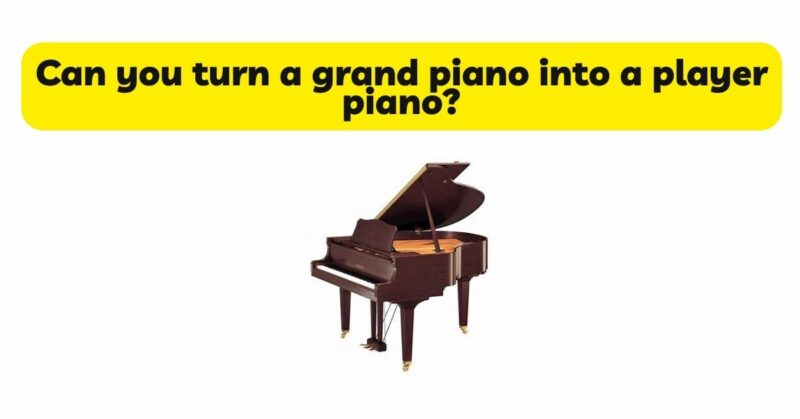The grand piano is a timeless instrument renowned for its majestic presence, rich tonal qualities, and the ability to captivate audiences with its melodic symphony. Meanwhile, the player piano, with its ability to reproduce music through automatic playback, adds a touch of technological marvel to the world of classical music. Combining these two elements might seem like an impossible task, but advancements in technology have made it feasible to turn a grand piano into a player piano. In this article, we will delve into the process of transforming a grand piano into a player piano, exploring the intricate details, benefits, challenges, and the potential impact of this remarkable fusion of tradition and technology.
- Understanding the Player Piano: Before exploring the transformation process, it is important to comprehend the workings of a player piano. A player piano incorporates a mechanical system that reads and interprets music rolls, translating them into actual piano key movements. The keys are depressed by a series of pneumatics or solenoids, allowing the instrument to play the desired piece with great precision.
- The Transformation Process: Converting a grand piano into a player piano involves several significant steps:
a. Assessment and Preparation: The first step is to carefully evaluate the grand piano’s condition and determine its suitability for conversion. Factors such as age, structural integrity, and the presence of any modifications play a crucial role. Additionally, preparing the piano by cleaning, tuning, and addressing any maintenance issues ensures a solid foundation for the conversion.
b. Player Piano Mechanism Installation: The next phase involves installing the player piano mechanism within the grand piano’s framework. This process necessitates precise measurements and careful consideration of the instrument’s internal components. The player piano mechanism, including the pneumatic or solenoid system, tracking bar, and tracker bar frame, is skillfully integrated into the piano structure.
c. Pneumatics and Key Connections: Connecting the player piano mechanism to the keys is a vital step. The pneumatics or solenoids are attached to the keys, allowing them to be activated by the mechanism during playback. This linkage is adjusted to ensure proper alignment and responsiveness, guaranteeing accurate reproduction of the music rolls.
d. Music Roll Installation: The heart of the player piano lies in its music rolls. These rolls, often made of paper, contain the encoded musical data that drives the mechanism. Installing the music rolls in the player piano system involves precise positioning and synchronization with the tracker bar, ensuring accurate interpretation and reproduction of the music.
- Benefits of a Grand Piano Conversion: Transforming a grand piano into a player piano offers numerous advantages, including:
a. Preservation of Legacy: By converting a grand piano into a player piano, one can preserve the traditional elegance and timeless beauty of the instrument. This transformation allows for the harmonious coexistence of classical aesthetics and modern technology.
b. Enhanced Musical Versatility: A player piano provides the opportunity to enjoy a wide range of musical styles effortlessly. With the ability to play various genres, compositions, and arrangements, it expands the repertoire and versatility of the instrument.
c. Educational Value: Player pianos serve as invaluable educational tools. Students, aspiring musicians, and enthusiasts can study and learn from the performances of renowned pianists and composers, gaining insights into technique, interpretation, and musical expression.
- Challenges and Considerations: While the conversion process brings numerous benefits, it is essential to consider the potential challenges:
a. Structural Modifications: Converting a grand piano into a player piano often requires structural modifications to accommodate the additional mechanism. These alterations should be carefully executed to preserve the piano’s tonal qualities and structural integrity.
b. Restoration and Maintenance: Ensuring the longevity of a player piano requires regular maintenance and restoration. The delicate nature of the mechanism and the need for periodic adjustment necessitate expert care to sustain optimal performance.
c. Authenticity and Artistic Interpretation: Some purists may argue that player pianos detract from the authenticity and artistic interpretation associated with live performances. However, it is important to remember that a player piano complements, rather than replaces, the experience of live music.
- Impact and Future Potential: The fusion of a grand piano and player piano technology opens up new possibilities for music enthusiasts, artists, and collectors. The continued advancement of technology may result in further enhancements, such as digital interfaces and connectivity options, enabling remote music playback and interactive experiences.
Conclusion: The transformation of a grand piano into a player piano harmoniously combines tradition and technology, enriching the musical landscape. By understanding the intricate process, appreciating the benefits, and considering the challenges, one can explore the potential of this remarkable fusion. The blending of a grand piano’s elegance and the automated playback capabilities of a player piano paves the way for a harmonious symphony of the past and the present, breathing new life into the timeless world of classical music.


